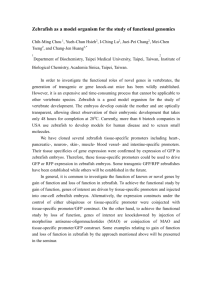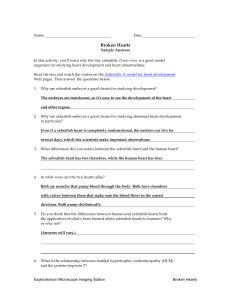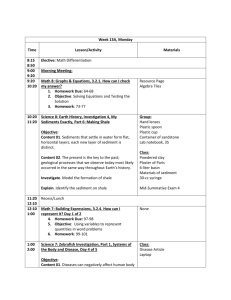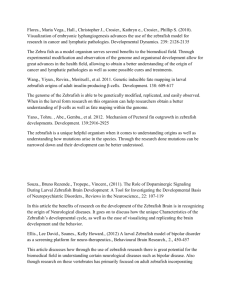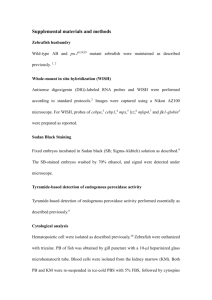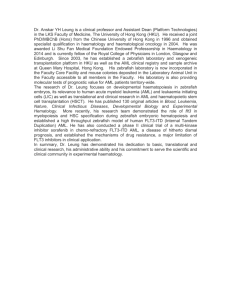Publishable executive summary
advertisement
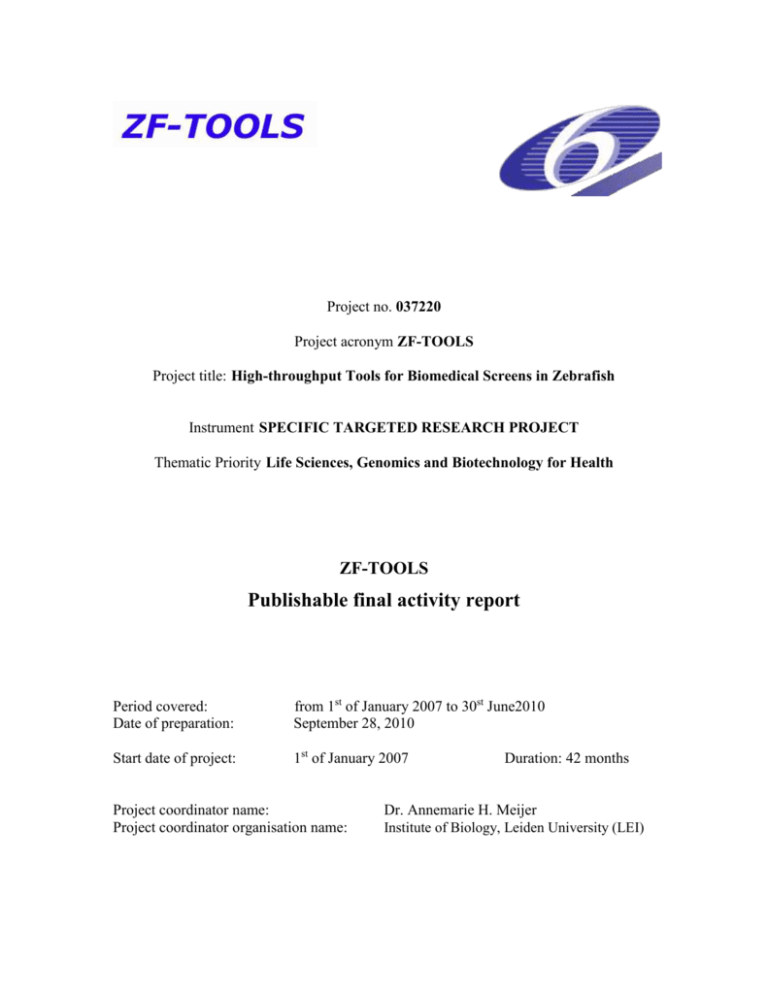
Project no. 037220 Project acronym ZF-TOOLS Project title: High-throughput Tools for Biomedical Screens in Zebrafish Instrument SPECIFIC TARGETED RESEARCH PROJECT Thematic Priority Life Sciences, Genomics and Biotechnology for Health ZF-TOOLS Publishable final activity report Period covered: Date of preparation: from 1st of January 2007 to 30st June2010 September 28, 2010 Start date of project: 1st of January 2007 Project coordinator name: Project coordinator organisation name: Duration: 42 months Dr. Annemarie H. Meijer Institute of Biology, Leiden University (LEI) Publishable final activity report Project Title: High-throughput Tools for Biomedical Screens in Zebrafish Project Acronym: ZF-TOOLS Contract Number: LSHG-CT-2006-037220 EC Contribution: 1,739,000 € Duration in months: 42 Starting date: 01-01-2007 Instrument: STREP Project web page: http://www.science.leidenuniv.nl/index.php/ibl/mcb/research_themes/zf_tools Coordinator Dr. Annemarie H. Meijer Institute of Biology, Leiden University Einsteinweg 55 2333 CC, Leiden, The Netherlands Phone: +31-71-5274927 Fax: +31-71-5274999 E-mail: a.h.meijer@biology.leidenuniv.nl http://www.science.leidenuniv.nl/index.php/ibl/meijer Other contractors ZF-screens BV, Niels Bohrweg 11, 2333 CA, Leiden, The Netherlands, www.zfscreens.com BaseClear B.V., Einsteinweg 5, 2302 BH, Leiden, The Netherlands, www.baseclear.com Zenon Bio Ltd., Maros St. 40., H-6721, Szeged, Hungary, www.zenonbio.hu Szeged University, Dr. Mátyás Mink, Dept. of Genetics, Kozepfasor 52, H-6726, Szeged, Hungary, www.u-szeged.hu Karlsruhe Institut für Technologie (KIT), Prof. Dr. Nicholas Foulkes, Hermann-vonHelmholtz-Platz 1, Eggenstein-Leopoldshafen, 76344, Germany, www.kit.edu 1. Project execution Summary The zebrafish holds much promise as a high-throughput drug screening model for immune-related diseases, including inflammatory and infectious diseases and cancer. This is due not only to the remarkable similarity of the zebrafish and human immune systems, but also to the excellent possibilities for in vivo imaging in combination with advanced tools for genomic and large scale mutant analysis. Furthermore, the millimeter size of the zebrafish embryos and larvae makes them highly suited for screening chemical libraries, since compounds can be administered simply to the embryo medium and only minute quantities are needed. In the ZF-TOOLS project we developed zebrafish-based screening systems for anti-tumor and anti-microbial drugs. We demonstrated that a novel robotic system can be used to implant fluorescently labeled tumor cells or microbes into zebrafish embryos at an unprecedented high-throughput level. The growth and metastatic behavior of implanted tumor cells or the proliferation of bacteria and their interaction with the zebrafish immune cells can be excellently visualized in the optically transparent zebrafish embryos, and quantified by coupling the robotic injector to an automated system for fluorescence sorting and image acquisition. This set-up was benchmarked for anti-tumor and anti-tuberculosis drug screening in the ZF-TOOLS project. Using a multidisciplinary functional genomics approach, where we integrated results from microarray analysis and next-generation deep sequencing, marker genes and microRNAs were identified with a predictive value for tumor progression or for immune defense responses of the zebrafish embryo. A subset of these markers was used to develop highthroughput assays for expression analysis. In addition, several oncogenic cell lines as well as luciferase reporter lines driven by oncogene or immune gene promoters were generated that present useful tools for biomedical research. Three biotech enterprises will commercially exploit the expertise on bioinformatics, high-throughput genomics analysis, and high-throughput drug screening that was gained in the ZF-TOOLS project. Objectives The ZF-TOOLS project was a coordinated effort of three research laboratories and three biotech enterprises (SMEs) aimed at the following objectives: Genomic-based marker discovery for biomedical screens in zebrafish. Use of high-throughput marker analysis and tumor cell implants for the identification of tumor growth and metastasis factors and organismal defense factors. The project aimed to develop a case study for an anti-tumor drug screening system, based on the implantation of fluorescently labeled tumor cells into zebrafish embryos. In this system, growth and metastasis properties of implanted tumor cells can be efficiently monitored by fluorescence microscopy during development of the transparent zebrafish embryos. We envisage that a powerful screening system can arise from the combination of highthroughput marker analysis with the possibility to visualize tumor growth and metastasis in an optically transparent vertebrate model organism. However, for realization of such a screening system, the identification of relevant disease marker genes in zebrafish formed a crucial step. In the ZF-TOOLS project different genomics approaches were used to discover novel markers, which will be suitable for application in the ZF-TOOLS tumor screening system and also will have a broader utility for disease research in the zebrafish model. The experimental design of our genomics approach was aimed to result in the identification of two classes of markers: 1) markers correlating with growth and metastasis of tumor cells and 2) markers correlating with the immune or other defense responses of the organism towards tumor cells. The reason for concentrating on both classes of markers is that interactions between developing tumors and the tumor microenvironment are decisive for tumor survival or rejection. Strategies to boost antitumor immunity have been explored for many years. Therefore, knowledge of tumor markers as well as defense response markers will increase the versatility of the anti-tumor drug screening system developed in the project. Approach Zebrafish cell lines carrying constitutive or inducible expression constructs of various oncogenes and cell lines derived from human tumors were fluorescently labeled and tested by implantation into zebrafish embryos. Several of these cell lines, most notably those carrying inducible oncogene constructs and those derived from human tumors, showed reproducible proliferation and migration behavior inside the zebrafish larval body and also elicited angiogenic responses. The best performing zebrafish cell lines were selected for transcriptome profiling using microarray analysis and deep sequencing. The data were compared with expression data of tumor tissues. In addition, extensive transcriptome profiling studies were performed to characterize the zebrafish host defense response toward tumor implants and these data were compared with responses to infectious agents. Immuno-deficient zebrafish were characterized to gain insight into the specificity of the defense response markers. For transcriptome sequencing we have used Illumina deep sequencing technology with which we could obtain up to 10 million sequence reads per sample. A dedicated data warehouse, the ZF-TOOLS database, was developed for storage and bioinformatic analysis of transcriptome sequencing data. Furthermore, a data processing pipeline for functional annotation of zebrafish genes was developed. Based on the genomic profiling studies, we have developed high-throughput expression assays. For this purpose we applied a multiplex PCR technique, RT-MLPA, which allows the analysis of 40-50 markers in a single one-tube assay. In addition, microarray data of tumor-and defense related small regulatory RNAs (microRNAs) were used to set up quantitative PCR assays, and the promoters of several tumor- or defense specific genes identified were used to generate luciferase reporter lines for cell-based assays. Finally, a novel robotics system was applied to obtain a proof-of principle for high-throughput screening of anti-microbial and anti-tumor drugs. To demonstrate the versatility of this system we have tested it using fluorescent tumor cell implants as well as mycobacteria that induce granuloma formation in zebrafish embryos similar as in human tuberculosis. Drugs used for cancer and tuberculosis treatment in human were tested in the zebrafish system. End results We have developed a high-throughput anti-tumor and anti-tuberculosis drug screening system, based on implantation of fluorescently labeled tumor cells or mycobacteria into zebrafish embryos. This screening system has the following unique features: It is based on novel robotics technology for injecting bacterial pathogens or tumor cells which has been benchmarked in the ZF-TOOLS project. It combines robotic injection of fluorescently labeled tumor cells or mycobacteria with automated image analysis for in-vivo monitoring of respectively tumor progression or mycobacterial granuloma formation in transparent zebrafish embryos. Visual monitoring of disease progression in transparent larvae can be combined with high-throughput molecular screening tools for tumor and defense response markers developed within the project. A prototype of the injection robot was benchmarked for anti-tuberculosis and anti-tumor drug screens and the screening procedures were fully standardized for case study screens with drugs used in human cancer and tuberculosis therapy. In addition, the ZF-TOOLS project generated extensive microarray and deep sequencing data sets of zebrafish oncogenic cells and tumor samples together with data on defense responses of the zebrafish host to tumor implants or infectious agents, resulting in: Knowledge on disease markers in zebrafish, more specifically tumor- and host defense-specific genes and microRNAs Assays for quantitative analysis of disease marker sets A collection of constitutive and inducible, oncogenic and non-oncogenic reporter cell lines useful for basic disease research and for application in screening systems Fundamental knowledge gained from the use of zebrafish cancer and infection models has been presented at scientific meetings and has now resulted in several publications in journals such as Blood, Journal of Immunology, and Molecular Immunology. Furthermore, with the knowledge of disease markers and expertise gained on bioinformatics, high-throughput genomics analysis, and high-throughput drug screening biotech enterprises involved in the project have strengthened their IP positions and expanded their service activities. Impact on the industry and research sector The ZF-TOOLS objectives were focused on the incorporation of the zebrafish embryo model into the preclinical drug screening pipelines. The use of mice for in vivo monitoring of disease processes such as tumorigenesis, metastasis and immune response to tumors or infectious diseases like tuberculosis is limited by costs and throughput level. Introducing a high-throughput zebrafish embryo model will potentially contribute to costeffective and more efficient methods in the anti-tumor drug discovery process. Acceleration of drug lead time benefits economy as well as quality of life of patients. With the development of a robotic system for injection of tumor cells and bacterial pathogens into zebrafish embryos the ZF-TOOLS project has provided a solution to enable high-throughput cancer and tuberculosis drug screens in the zebrafish model. In addition, the lack of basic knowledge of disease marker genes has been a bottleneck for biomedical research in zebrafish and for genomics-based compound screens in this model organism. The ZF-TOOLS project has used multidisciplinary functional genomics approaches to discover novel disease markers. The identification of factors important for tumorigenic properties and organismal defense responses has contributed fundamental knowledge relevant to human health and will open the door to the establishment of zebrafish-based biomedical research and screening tools. 2. Dissemination and use Zebrafish-based anti-tuberculosis and anti-tumor drug screening • Result description: Robotic system for injection of bacterial pathogens and tumor cells into zebrafish embryos. • Possible market applications: High throughput screening of small molecule libraries for anti-microbial and anti-tumor drugs • Stage of development: prototype benchmarked for anti-tuberculosis and anti-tumor drug screens, standardizations performed, validation with human cancer drugs in progress • Collaborator details: ZF-screens B.V., Leiden University, Institute of Biology • Intellectual property rights: WO 2006/080841 A1, US # 61/233,805, Europe # 09164956.6 • Contact details: Dr. Ron Dirks, ZF-screens BV, Niels Bohrweg 11, 2333 CA, Leiden, The Netherlands, www.zfscreens.com Tumor markers in zebrafish • Result description: Knowledge of tumor-specific markers in zebrafish • Possible market applications: anti-tumor drug screening • Stage of development: expression assays tested up to medium throughput level, high throughput applications under development • Intellectual property rights: US # 61/233,805, Europe # 09164956.6 • Collaborator details: ZF-screens B.V., Leiden University, Institute of Biology • Contact details: Dr. Ron Dirks, ZF-screens BV, Niels Bohrweg 11, 2333 CA, Leiden, The Netherlands, www.zfscreens.com Macrophage and immune response markers in zebrafish • Result description: Knowledge of infection-induced and macrophage-specific markers in zebrafish (Hegedus et al., 2009, Stockhammer et al., 2010, Zakrzewska et al., 2010, Ordas et al., 2010, Stockhammer et al., 2010) • Possible market applications: application in anti-microbial drug screening • Stage of development: Research will be continued in the context of the EU-funded ZFHEALTH consortium, the Smartmix consortium funded by the Dutch government, and with a horizon grant from the Netherlands Organization of Scientific Research. Transgenic reporter lines for immune-response and macrophage markers are currently under construction. • Collaborator details: Leiden University, Institute of Biology; Szeged University, Department of genetics, ZF-screens B.V. • Contact details: Dr. Annemarie H. Meijer, Institute of Biology, Leiden University, Einsteinweg 55, 2333 CC, Leiden, The Netherlands, Phone: +31-71-5274927, Fax: +3171-5274999, E-mail: a.h.meijer@biology.leidenuniv.nl Mycobacterium-induced host genes as potential diagnostic tools for tuberculosis • Result description: gene expression profiles specific to mycobacterium infection • Possible market applications: clinical screening system for diagnosing tuberculosis • Stage of development: The Hungarian Development Agency has granted a project proposal aiming to develop the prototype of a clinical screening system for diagnosing tuberculosis. This project is based on the hypotheses that the gene expressional alterations observed in Mycobacterium marinum-infected zebrafish (Hegedus et al., 2009) may occur in human patients and the expressional alterations are followed by translational changes in the same directions. We plan to analyse serum proteins by Western of about 25-30 tuberculosis patients and matching controls, provided by the pulmonologists. The number of the candidate markers will be ~25. Markers with statistically significant changes will be selected for an ELISA-based screening test. We expect to develop a prototype, which is cheap (USD 5/test), high throughput (processing of 50 blood samples a day) system that we will offer to tuberculosis-endemic countries (Russia, China, India). These expected properties of the screening system may make superior over the time-consuming, laborious, complicated and expensive screening systems. • Collaborator details: Szeged University, Department of Genetics; Szeged University, Pulmonology Clinics; Creative Ltd. (Szeged, Hungary) • Contact details: Dr. Mátyás Mink, Szeged University, Dept. of Genetics and Molecular Biology Kozepfasor 52, H-6726, Szeged, Hungary, Phone: +36 62 544269, Fax: +36 62 544651, e-mail: mink@bio.u-szeged.hu. High-throughput sequencing services • Result description: Expertise on Digital Gene Expression library preparation and highthroughput sequencing using the Illumina Genome analyzer II system. • Possible market applications: Illumina sequencing technology has a range of possible applications in the area of biological research and analysis, including genome sequencing, transcriptome sequencing and Chip-Seq. • Stage of development: A Genome Analyzer II system was installed in December 2008 and commercial services are now being offered to customers with more than 18 months of experience. Collaborator details: BaseClear B.V and ZF-screens B.V. • Contact details: Dr. Derek Butler, BaseClear B.V., P.O. Box 1336, 2302 BH, Leiden, The Netherlands, www.baseclear.com DeepSAGE sequencing bioinformatics service • Result description: special knowledge about the large scale bioinformatics analysis of data derived from high throughput SAGE based transcriptome profiling studies. • Possible market applications: ZenonBio Ltd. offers their expertise on bioinformatics of deep sequencing data for customers and potential collaborating partners requiring a related custom bioinformatics data analysis service. • Stage of development: The offered service covers the entire data processing workflow from the first conversion steps of the raw sequencing data up to the final data annotation and data interpretation subtasks. The bioinformatics pipeline we use contains modules assessing the sequencing quality, mapping sequence tags to reference genome or reference transcript databases and performing statistical comparison of different experimental samples. The custom data analysis service ZenonBio Ltd. offers might be primarily useful for research laboratories and biotech companies specialized for genomics, transcriptomics and system biology. • Contact details: Dr. Tamás Forrai, Zenon Bio Ltd., Maros St. 40., H-6721, Szeged, Hungary, Phone: +36 62 424290, Fax: +36 62 476558, e-mail: tforrai@zenonbio.hu MLPA technology custom service • Result description: High-throughput expression assays based on multiplex PCR technology (RT-MLPA). Developed protocol, and gained knowledge and experience on the development of RT-MLPA probe sets and additionally in the area of analysis and interpretation of MLPA data and results. • Possible market applications: Possibility to offer a commercial RT-MLPA probe development service based on the RT-MLPA probe sets developed. Additionally BaseClear is already offering commercial MLPA analysis services and is currently working on a number of projects in this area. • Stage of development: A number of RT-MLPA probe sets are complete. The MLPA assay services are currently being offered to customers and at least one project is currently being performed. • Contact details: Dr. Derek Butler, BaseClear B.V., P.O. Box 1336, 2302 BH, Leiden, The Netherlands, www.baseclear.com




